—Real-world variables beyond your control that slow construction
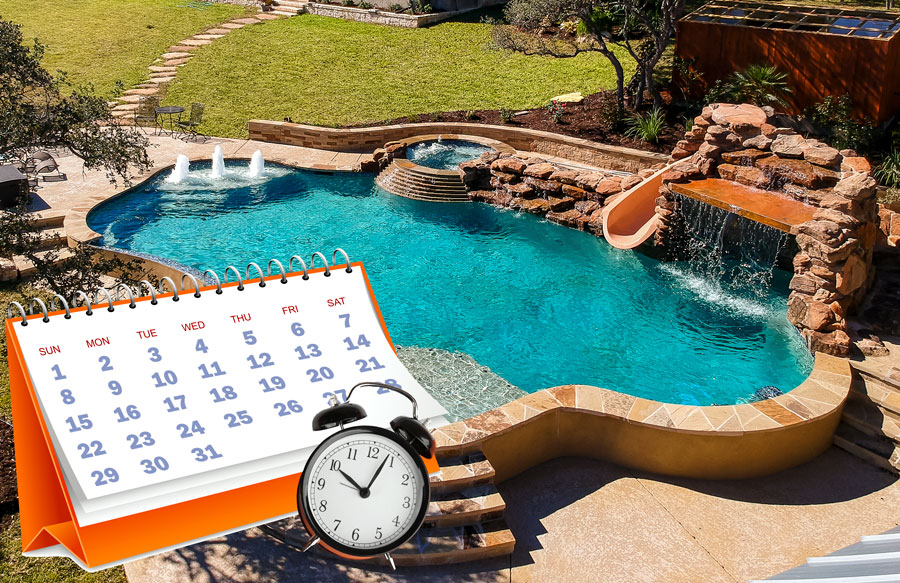
Just how long will it take to finish building your inground pool?
Let’s be candid: Rome wasn’t built in a day—and neither will your new backyard aquatic resort. Nor will your custom pool be finished in a week. Or in a month.
After all, ancient rulers Romulus and Remus needed time for construction, and so will your pool builder.
Even a relatively basic gunite pool requires a number of trades and construction elements that your contractor must coordinate correctly, and that takes time.
In some markets around the country, depending on the best-case scenarios we discuss below, a simple gunite design might reach the finish line two months from excavation day.
But the truth is that with so many variables coming into play—including where you live in the U.S., unique backyard conditions, and the complexity of your design—it’s hard to pin down the typical number of weeks it may take before your pool is ready to fill with water.
Generally speaking, timeline variables fall into two broad categories. The first are those under your control. Examples are the time of year you decide to build or choosing custom-order tile, stone, or pavers that must ship from across the country.
Other variables lie outside your influence. Here’s a look at some of the common ones that can impact the progress on gunite pool construction.

The hard reality is that many variables that impede pool-construction timelines are simply beyond your control—and often beyond that of your contractor’s as well.
1. Homeowner Associations (HOAs)
Do you live in a community with a homeowners association? If so, right from the get-go you can expect a slow start on a new pool.
The rules and roadblocks stemming from the presence of HOAs frequently set back the construction process. Typically this occurs early on, during the initial planning.
Whether it’s easements and setbacks or waiting for the monthly architectural committee meeting to review your project plan, an HOA can be a time-sucking pain.
To mitigate neighborhood noise levels and parking congestion, your association rules may limit the days of week and times of day that construction crews, vehicles, and heavy machinery are allowed into the community.
Design parameters create another area of HOA concern. For example, say your plan includes a big swimming pool slide.
However, during the architectural review, the board or committee may reject the slide if it violates backyard structure height restrictions. If you end up appealing the decision, count on waiting until the next meeting.
Other than being fully aware of your HOA rules and restrictions and doing your best to stay ahead of them, there’s not much else you can do. So factor in extra time before any work can begin.

Most homeowners associations require construction projects like a swimming pool to undergo formal review by the board or its architectural committee.
2. Regional markets
The availability and speed of gunite pool construction vary a great deal from place to place.
Major metropolitan areas in the Sunbelt, such as Dallas or Las Vegas, are populated with many capable pool builders.
By contrast, smaller markets in the same Sunbelt region—such as Abilene, Texas or Reno, Nevada—may have only a bare handful of gunite builders.
Or, if you live in the Midwest or Northeast in a large city, you may find qualified builders. But due to a shorter building season in these climates, they may book up projects for the entire year quickly and far in advance.
In certain markets, that means you may have to wait longer for a builder to schedule and begin your project.
In regions where there’s limited availability of gunite pool builders, help yourself by planning ahead and setting realistic expectations of how soon you will be able to swim.

Where you live can dramatically impact construction time. For example, under normal conditions, the same pool that takes six weeks to finish in Phoenix might take three months in Charlotte.
3. Permits in your municipality
Another way where you live can impact pool construction timeline relates to building permits.
Now, if you live in a rural area or—in some states—a suburb, you may be in luck: Local agencies may not require a permit for an inground pool. But typically, this is the exception to the rule.
How long it takes to obtain permits varies wildly, from a few days to weeks—and in some areas, even months.
Again, the time of year may play a role: The same building department may turn around a permit in November a heck of a lot quicker than it will in April when a flood of applications comes in.
Even in the same county, the speed of permit issuances can cross the spectrum. One city may crank out permits in a week; another two months.
The size of the metropolitan market and current construction activity can make a big difference. So can government funding of a planning department’s budget. In some cases, a recent regulatory change creates confusion and takes time for proper implementation.
However, some departments are simply far faster, and some contractors would say more or less competent than others.

Your local gunite pool contractor is an expert in your market. They understand how long municipal agencies take to review plans and issue permits.
4. Seeking a code or rule variance
In rare cases, a pool project will require a “variance.” A variance is a formal approval—or “exception” granted by a government agency. In effect, it’s permission to violate an existing zoning regulation, guideline, or standard.
Variances comes into play when for a special reason, a project design does not comply with building department codes.
A common example is encroaching on property-line setbacks or environmental easements. Another is when a pool’s square footage would exceed the allowable space limits for “impermeable surface.”
Your pool contractor will provide you with some assistance in applying for a variance. In some cases, before you even apply, you will first have to ask a utility company for formal approval.
Waiting for a variance can be time-consuming and frustrating. The process varies from place to place. Some variances take weeks, others months.
Some requests get denied. As a result, you might be forced to alter your design. For example, you may need to reduce the pool dimensions or to change the pool’s position in your backyard.
Having a pool builder who knows the ropes with local building departments and other relevant agencies is a big plus.
But at the end of the day, securing a variance approval does take time and is out of your hands.
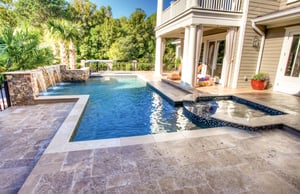 In small backyards, meeting a municipal code may be tougher. For example, building regulations typically require a minimum distance between the pool edge and the property line.
In small backyards, meeting a municipal code may be tougher. For example, building regulations typically require a minimum distance between the pool edge and the property line.
5. Mother Nature—inclement weather
Of all pool-construction timeline factors, the weather is the least controllable. It’s also one of the most formidable.
Rain, wind, snow, and even extreme heat or humidity can have both predictable and unpredictable impacts on the construction process.
And it’s always an unwanted impact. No two ways about it, you can count on inclement weather creating pool construction delays. It does so in multiple ways.
Worse yet: Know that one day of inclement weather, such as rain, does not equal a one day delay. It creates a longer work stoppage, as a domino effect ensues.
Why? Because lousy weather like rain forestalls not only your scheduled work—such as steel installation—but scheduled work on other pools around town.
In fact, it may not even rain at your home, but the downpour across town impacts you. Let’s say that again: The downpour across town impacts your project. It throws a wrench in your pool builder’s schedule because they have projects over there.
Factor in that the ground may take several days or longer to dry out. Certain phases of pool construction cannot proceed with wet earth..
Here’s yet another way weather gets in the way. If you live in a climate where the ground freezes during the winter, your builder will be unable to start your pool until the ground thaws.
Even worse: In some years, the thaw comes later—thereby creating a logjam of pools awaiting excavation.
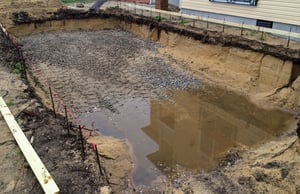
A sudden downpour can wreak havoc on an excavated pool hole, causing its fill with water or for the dirt walls to slough off into a muddy pile at the bottom.
6. Natural disasters
Hurricanes, wild fires, tornadoes, mudslides, and earthquakes. These natural disasters potentially lead to loss of life, injuries, and other physical dangers. These days, you can also add worldwide Covid pandemic to the list.
In addition to the incredible property and infrastructure damage they wreak, any of these phenomenon can bring your pool construction to a screeching halt. Expect a massive interruption.
Following the disaster, progress stalls until certain activities are completed. Tasks might include clearing backyard debris, restoring power lines, repairing gas and electric lines or hazards, performing safety inspections, and so on.
When disaster strikes, demand surges for crews in many different building trades in the local area or across an entire state or region.
Building pipelines for swimming pools—as well as a full range of other residential and commercial projects—back up
Since the onset of the current viral “natural disaster,” sales of pools have skyrocketed. Coupled with some supply-chain problems and shortage of top-tier crews, this sales boom has produced significant building delays around the country.
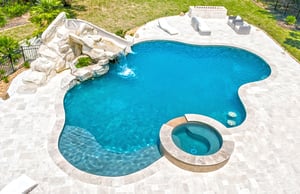
Spurned by Covid’s curtailing of leisure travel and the new stay-at-home culture, pool builders nationwide have seen unprecedented demand.
7. Unexpected pool-site issues
Digging big holes can be full of surprises. And unlike buried treasure, they are never the kind of surprises that you would actually enjoy.
Underground obstacles run the gamut. Among the more common ones: rock formations, unstable soil, groundwater, or unidentified utility lines.
Less common but certainly heard of: a decades-old pool a previous homeowner filled in or remnants of an earlier deck or home foundation.
Unwanted “finds” will throw a wrench in any construction schedule. Before work can continue, your builder must remove the obstacle, pump out water, or otherwise resolve the issue.
For example, say your property contains an old gas line that the power company never put into its records. Today, it lies in the way of your future pool. So now your builder may have to arrange its move to a new location.
Or, you could discover your property—or part of it—was built on landfill that was not properly compacted.
To provide a stable environment that supports your pool shell, extra steps may be needed. Your builder may need to remove the existing fill and replace it with “competent” soil.
Or, the excavation crew hits rock in your backyard earth. Special heavy machinery may need to be brought in to break up the hard formations.
Any effort like these require additional job-site visits and scheduling. It may also require other special arrangements or logistics.
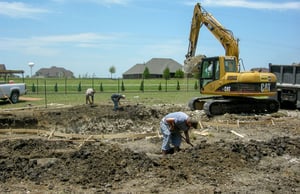
What lies beneath? Sometimes, it’s an unwanted obstacle that will delay progress until your builder develops and executes a solution.
8. Construction "stuff" that happens
It’s true of all types of construction, there’s much to be said for “expecting the unexpected.”
Random workflow disruptions can come from a variety of sources. Among them are failed inspections, sick or injured workers, scheduling conflicts, equipment breakdowns, delivery delays, uncooperative neighbors, site vandalism, theft, or even swarms of stinging insects.
Government shutdowns or employee furloughs can cause logjams in permit approvals, such as homeowners in some regions experienced during the Covid pandemic.
Clearly some of these speed bumps are far more common than others.

Did you order a custom-made feature or special tile or stone that’s coming from out of state? Manufacturing or shipping delays can halt the building process.
Worth the wait?
You may be thinking that this is a scary list of potential delays—and you’re right.
But anticipating delays is part of having realistic expectations. Understanding the nature of the setbacks and why they occur won’t make work happen any faster, but it may help a bit with your patience.
Sure, in some cases, the planets fall into perfect alignment, and your pool builder will finish your project right on schedule—sometimes even ahead of it. But sometimes they do not.
However long your job takes, never lose sight of the goal. At the end of the process you will have a permanent, wonderful aquatic playground.
Your new pool will provide your family with years of enjoyment, health, togetherness, pride of ownership, and a private retreat where the good life unfolds. And that is certainly worth the wait!
Prefabricated above-ground pools, fiberglass shells, and vinyl-liner installations may finish quicker, but they cannot hold a candle to a gunite design’s versatility for customization and lasting beauty.





.jpg?width=1490&name=rock-waterfall-slide-pool%20(1).jpg)